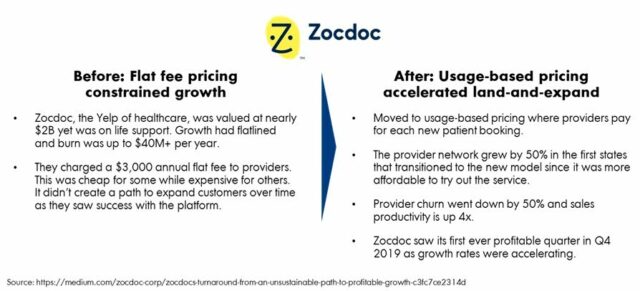For Software as a Service (SaaS) companies, usage-based pricing, or consumption-based pricing is quickly becoming a cornerstone. The shift to a consumption-based pricing model challenges sales and revenue operations teams to rethink their forecasting challenges.
This comprehensive guide explores what usage-based pricing is, its benefits, and the challenges SaaS companies can face during implementation.
Understanding Usage-Based Pricing for SaaS
Usage-based pricing is a dynamic model where customers pay based on the extent of their usage of a product or service. Unlike traditional SaaS subscription models that charge a fixed rate per user or feature, Usage-Based Pricing adapts to each customer’s needs, allowing them to pay less when they use less and more as their usage increases.
This flexibility not only makes it easier for new customers to adopt a product due to lower initial costs but also encourages existing customers to explore and utilize the software more comprehensively. Such engagement often leads to discovering new use cases, enhancing customer satisfaction, and ultimately, increasing customer lifetime value.
By mastering consumption-based forecasting, companies can achieve sustainable growth, optimize customer lifetime value, and stay ahead in fast-changing markets.
The Rise of Usage-Based Models for SaaS
The prevalence of usage, or consumption-based pricing models in the B2B SaaS sector has nearly doubled over the past five years. Currently, 60% of companies are either fully implementing or experimenting with consumption-based pricing.
A significant shift has occurred in the enterprise SaaS market when it comes to who holds the purchasing power. Users who are part of business or engineering teams seem to hold the most power as they often need to experience the value of a product before committing financially. The adoption of usage or consumption-based billing caters to this particular audience by enabling users to begin with minimal or no initial costs and scale their payments as their usage increases.
Many SaaS companies are blending usage-based pricing with traditional models to cater to diverse customer needs. This hybrid approach allows businesses to maintain stable recurring revenue while also capitalizing on high-usage opportunities.
SaaS companies like ZocDoc and DataDog have fully transitioned to usage-based models, benefiting from the scalability and flexibility it offers. These companies have tailored their pricing structures to align closely with value delivery, which in turn has accelerated their revenue growth.

Benefits of Usage-Based Pricing for SaaS
The shift to usage-based pricing for SaaS companies is not just a trend but a strategic move given its clear advantages.
Scalability: It widens your total addressable market by making your product more accessible and removing limits on potential growth. SaaS companies utilizing usage-based pricing can tap into markets beyond their typical customer profiles without additional marketing or sales efforts. This expansion is not only profitable but also drives the development of new features and refines GTM strategies.
The consumption model supports a ‘land-and-expand’ strategy, moving away from traditional seat-based pricing. This enables more individuals within an organization to use your product in their daily tasks and processes. Success in one user group often leads to broader adoption within the organization or even referrals to external partners or peers.
Customer Insight: Usage-based pricing puts more attention on the customer’s actual use of products, providing valuable data and insight back to your organization. Being able to understand how often your products are being used gives you visibilty into current customer satisfaction and can even help predict customer churn or potential upsell opportunities.
Financial Upside: Enhanced customer retention and acquisition metrics, such as Customer Acquisition Cost payback and Net Dollar Retention, are often seen with consumption-based pricing. It also offers an entry point at a lower cost, which reduces barriers to adoption. In today’s market, delivering immediate value at minimal or no cost is the most effective strategy for acquiring customers. Demonstrating value from the start is vital for a robust, product-led go-to-market (GTM) strategy.
Challenges implementing Usage-Based Pricing for SaaS
Adopting a usage-based pricing model for SaaS companies requires thoughtful planning and robust systems. Some potential challenges include:
Data Silos and Chaotic Data: Many businesses struggle with consumption data spread across disconnected systems such as CRMs, ERP platforms, and data warehouses. This data often comes in chaotic formats, demanding significant effort for cleansing, transformation, and integration before it can effectively power forecasting models. Without a unified, standardized data framework, forecasts are prone to inaccuracies.
Revenue Forecasting: With traditional subscription models, revenue is predictable due to fixed recurring payments. In contrast, usage-based pricing can lead to fluctuations in revenue, as customer usage can vary significantly from month to month. This variability makes it difficult for companies to forecast future revenues accurately, which can complicate budgeting and financial planning. One solution for this is to implement a forecasting tool, such as revVana, to keep all of your forecasting data inside of Salesforce.
Customer Behavior Prediction: Predicting customer usage can be complex, as it may fluctuate due to seasonal trends, changes in customer needs, or external market dynamics. This unpredictability can lead to challenges in scaling operations and managing resources efficiently.
Financial Stability and Cash Flow: Because revenue from usage-based pricing can be less predictable, it can impact the cash flow stability of a company. This variability might affect the ability to invest in long-term growth initiatives or manage operational expenses effectively.
These challenges illustrate how critical it is to have the right systems and processes in place before switching to a consumption-based model.
Forecasting Usage-Based Pricing for SaaS
Using revVana’s revenue forecasting platform can significantly streamline usage-based pricing forecasting for SaaS companies. revVana offers a complete forecasting solution built on Salesforce to integrate actual usage data with sales forecasts, enabling SaaS businesses to:
Blend Various Revenue Types: Beyond just usage-based revenue, revVana allows SaaS businesses to forecast and blend different revenue streams, providing a comprehensive and complete revenue picture inside Salesforce.

Forecast and Track Actuals: By integrating actual usage data into Salesforce, SaaS companies can compare forecasts against actuals and targets, adjusting their strategies in real time.

Engage Customers Proactively: revVana provides a running total of usage month over month, allowing you to monitor consumption trends and make decisions. It also enables you to track the total usage against original volume commitments, ensuring that you stay on track with contractual obligations and efficiently manage supply needs. With accurate forecasts, businesses can engage customers more effectively, addressing under or over-utilization before it impacts billing or service satisfaction.

As more SaaS companies adopt usage-based pricing, understanding its nuances becomes crucial. By aligning price with customer value and usage, SaaS companies can not only attract a broader customer base but also enhance their growth and profitability in a competitive market. With strategic implementation and robust forecasting tools like revVana, usage-based pricing can transform how companies operate and succeed in the SaaS industry. Schedule some time to talk with us now.









